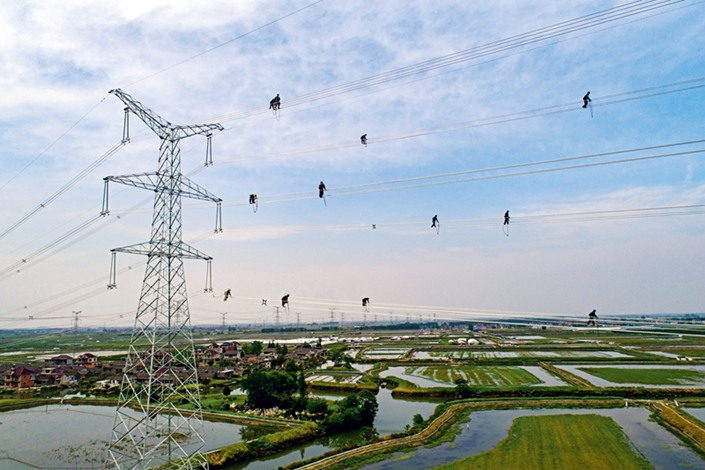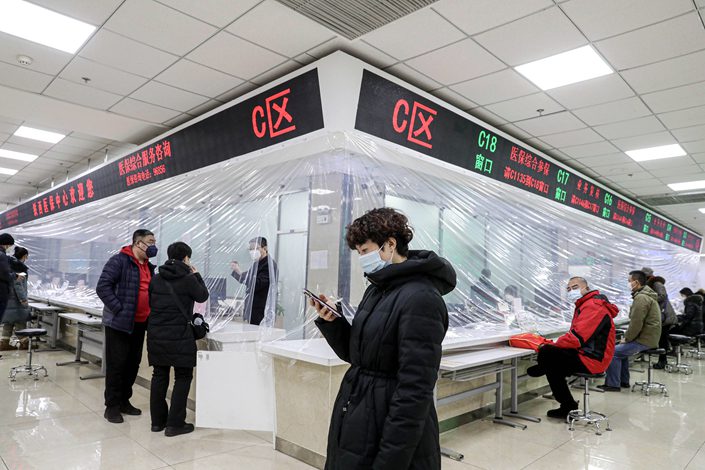CX Daily: China Pushing for International Covid-19 Vaccine Recognition System

Power /
Cover Story: Power revamp rebooted as state grid resumes divestiture plan
China’s long-stalled power industry overhaul is regaining steam as the country’s largest state-owned grid operator resumes efforts to downsize its mammoth business after nearly a decade of resistance that blocked further restructuring industrywide.
State Grid Corp., the larger piece of China’s power transmission duopoly and the world’s biggest utility, is expected to spin off all of its equipment manufacturing operations by the end of 2021, according to a timetable unveiled by the National Development and Reform Commission (NDRC), China’s top economic planner.
Equipment-making units to be split from State Grid will include Xuji Group Corp., Pinggao Group Corp., Shandong Electrical Engineering & Equipment Group Co. Ltd. and NARI Group Corp., according to Xu Shanchang, a senior NDRC official, in a November speech.
Two Sessions /
Two Sessions 2021: China targets tech self-reliance with massive research spend
Over the next five years, China plans to invest substantially more in research on basic technology. The March 5 draft of China’s 14th Five-Year Plan outlines a drive for self-reliance in science and technology.
The draft establishes three major indicators. From 2021 to 2025, China’s research and development (R&D) spending will increase by more than 7% a year. The number of high-value patents per 10,000 people will increase from 6.3 in 2020 to 12 in 2025. The added value of digital-economy core industry as a proportion of GDP will rise from 7.8% in 2020 to 10% in 2025.
The word “innovation” occurs frequently in China’s five-year plan for the second time. In the draft of the 14th Five-Year Plan, “Insisting on Innovation-Driven Development” was presented as the second chapter, underscoring its importance.
Opinion: Takeaways from China’s 2021 government work report
Two Sessions 2021: China plans to beef up laws to combat foreign sanctions
FINANCE & ECONOMY
Although authorities have been reassuring the public that pensions will be paid in full and on time, experts have expressed concern about the sustainability of the pension funds as the working-age population’s share of the total continues to shrink.
Social insurance funds /
China’s social insurance funds report first deficit on record
China’s social insurance funds reported the first annual deficit on record last year after authorities cut corporate contributions to help companies offset the fallout from the Covid-19 pandemic, according to a new government budget report.
The shortfall highlights the costs of one aspect of China’s Covid-19 relief effort last year as the country’s social insurance system took a financial blow at a time when experts were already worried about its long-term sustainability.
Even taking into account nearly 2.1 trillion yuan ($137.1 billion) in government subsidies, the social insurance funds disclosed a shortfall of 621.9 billion yuan for last year after reporting a surplus of 841.1 billion yuan in 2019, official data show.
Fiscal policy /
China’s 2021 fiscal policy will be ‘proactive and more sustainable,’ finance chief says
Finance Minister Liu Kun said fiscal policy will be “proactive and more sustainable” this year as Beijing plans to slowly phase out stimulus and as the economy recovers from the impact of the domestic coronavirus pandemic.
His remarks came as the finance ministry released its 2021 budget report at the annual sessions of the National People’s Congress (NPC) in Beijing Friday, saying the government is targeting a fiscal deficit for the year of “around 3.2%” of GDP with a deficit projection of about 3.57 trillion yuan ($547.6 billion).
That estimate is lower than “more than 3.6%” last year but slightly higher than analysts’ expectation of around 3%.
Editorial: Understanding China’s policy of ‘no sharp turn’
Trade /
China has ratified RCEP free trade pact, commerce minister says
China has formally ratified the 15-country Regional Comprehensive Economic Partnership (RCEP) free trade agreement in the Asia-Pacific region, Minister of Commerce Wang Wentao said Monday.
Wang told reporters on the sidelines of the country’s annual national political gatherings that other member countries have also stepped up efforts to ratify the deal.
In mid-November, a total of 15 Asia-Pacific countries — including China, Japan, South Korea, New Zealand, Australia and 10 members of the Association of Southeast Asian Nations — signed the world’s largest regional free-trade agreement.
Covid-19 /
China pushing for international Covid-19 vaccine recognition system
China plans to issue electronic health certificates and implement mutual recognition of other countries’ Covid-19 tests and vaccinations, its foreign minister said Sunday.
Beijing will also set up regional inoculation stations in other countries to help overseas Chinese nationals obtain coronavirus shots, Wang Yi said at a press conference.
The moves indicate that China may loosen some of its stringent travel restrictions for people who can prove they are either immune to the virus or not infected with it.
U.S. to extend tariff exclusion on China virus supplies 6 months
Quick hits /
New U.S. Commerce secretary pledges to use ‘entity list’ to ‘full effect’
Foreign minister confirms China will ratify U.N. conventions on forced labor
China is 30 years away from being a manufacturing powerhouse, minister says
BUSINESS & TECH
In an industrial park outside the central Chinese city of Wuhan, the site of chipmaker HSMC is now populated only by several idle cranes and three buildings in various stages of construction. Photo: VCG
Chips /
Exclusive: Idle cranes, unfinished buildings are all that’s left in China’s former field of chip dreams
Located in an industrial park outside the city of Wuhan, Hongxin Semiconductor Manufacturing Co. Ltd. (HSMC) was meant to become a $19.8 billion showcase and central plank in China’s plans to create a homegrown microchip industry capable of challenging the West.
Today that same land parcel is mostly quiet, populated only by several idle cranes and three buildings in various stages of construction. One was meant to house the company’s administrative offices, while the other two were meant to produce chips using 14- and 7-nanometer technology, putting them at the cutting edge of the global chip-making industry.
A recent visit to the compound showed the Hongxin name, once a badge of honor, had been removed from nearly all buildings and other structures inside. The name was even covered up on signage at a nearby public bus stop that had incorporated the company’s name.
In Beijing and Washington, leaders signal a growing tech arms race
IPO /
Q&A site Zhihu to test U.S. IPO market after crackdown on Chinese listings
Zhihu Inc., the Chinese question-and-answer forum often likened to Quora, filed for a U.S. initial public offering, marking one of a dwindling number of Chinese companies seeking such listings in the face of scrutiny by Washington.
The still money-losing Beijing-based company, whose site encourages users to ask and answer questions from other participants, aims to raise $100 million from the listing, according to a prospectus submitted to the U.S. Securities and Exchange Commission Friday.
Zhihu bills itself as the largest Q&A-style platform in China, both in terms of monthly active users (MAU) and revenue. Users totaled 75.7 million at the end of 2020, according to data from research firm China Insights Consultancy.
Logistics /
JD Logistics hops on China’s high-speed rail with new joint venture
The logistics arm of e-commerce giant JD.com Inc. will form a joint venture with China’s national rail operator, as the money-losing pair seeks to take advantage of the nation’s state-of-the-art train network that includes tens of thousands of kilometers of high-speed rail.
China State Railway Group Co. Ltd., also known as China Railway, will own the majority 55% of the venture, while the remainder will be held by the money-losing JD Logistics, the pair announced Friday. JD Logistics filed last month to make an IPO in Hong Kong, which would make it JD.com’s third publicly-traded unit, despite bleeding money since it began operating 13 years ago.
Airlines /
Airliner captain and chief flight attendant fired after midair scuffle
A commercial airline captain and head flight attendant who scuffled in mid-air have been suspended from work, Donghai Airlines said in a statement, after news of the fight circulated on an aviation-focused WeChat account Sunday.
The fight broke out after a passenger was spotted in the corridor outside a bathroom used by the cabin staff, potentially jeopardizing flight safety, people in the industry told Caixin. The captain blamed the head flight attendant for not clearing his way to the bathroom and accused him of neglecting his duties.
The incident happened 50 minutes before the Donghai Airlines flight from the eastern city of Nantong, Jiangsu province landed in the northwestern city of Xianyang in Shaanxi province.
Quick hits /
China gives nuclear power a fresh push in drive to go green
State-owned utilities raise 9 billion yuan via new ‘carbon neutral bonds’
Online educator GSX returns to losses despite dramatic revenue growth
Thanks for reading. If you haven't already, click here to subscribe.
- MOST POPULAR




